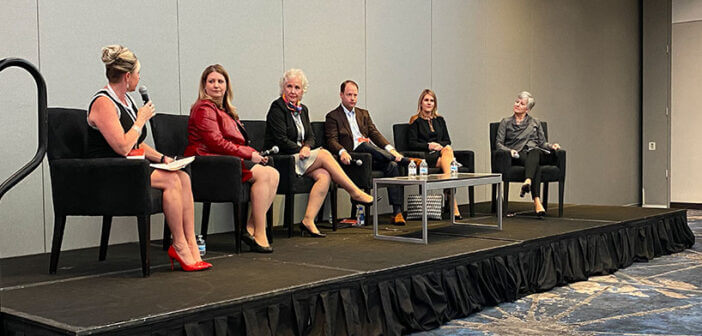During the session “The Lodging Industry Landscape: View from the Upscale Segment,” at the 43rd Annual NYU International Hospitality Industry Investment Conference, leaders gathered to discuss the current state of the upscale segment.
Moderated by Hotel Business VP, Content & Creative Christina Trauthwein, the panelists included Janis Cannon, SVP, Choice Hotels International; Amy Hulbert, VP, boutique and upscale brands, BWH Hotel Group; Alex Kuhl, VP, development, upscale and luxury, IHG Hotels & Resorts; Diane Mayer, VP/global brand manager, classic select brands, Marriott International; and Angès A. Roquefort, global chief development officer, Accor.
Although no segment was left unscathed by the pandemic, the upscale segment has enjoyed the unique ability to pivot and adapt to the changing traveler, while remaining attractive to investors.
“[The upscale segment] has been able—with already leaner staffing models, already leaner operating models, not being dependent on group business, not being as dependent on international inbound—to weather the storm a little bit better,” Mayer said. “And historically, they’ve provided really strong margins. Room margins are stronger than food and beverage margins, typically. So, it’s more of a room-focused product with a little bit of food and beverage, which has meant that their GOPs, five, sometimes 10% more on average higher than upper-upscale or premium product has meant they’re a little more approachable for investments and a little more profitable on their bottom line.”
Kuhl noted that properties in the segment tend to be less expensive to build than the upper-upscale tier, but that it’s their flexible model that allows them to thrive, and which drives conversations with investors.
“Depending on the location and competitive segment, you can push rate whereas a more traditional, let’s say midscale brand, there’s a perceived rate ceiling,” he said.
Cannon noted that with no rate ceiling, upscale brands have been able to recover quite well, with many of the hotels able to achieve upper-upscale rates.
“I think the other benefit is really from a total cost of ownership on the profitability side. We’ve actually been able to reduce costs and things like housekeeping…we’re rethinking food and beverage…top line revenue is growing dramatically,” she said.
Hulbert agreed, noting that holding rate is key to driving recovery within the segment.
“It’s all about making sure that we maintain that rate and pull that and we’re getting the right customer in, we’re getting them to be loyal and to continue to understand what that upscale product is instead of trying to just drop rate until we until we fill up the hotel,” she explained. “I think that’s been a really smart strategy as we work through recovering here.”
Supporting owners has been another key to recovery, Hulbert said, noting that her company gave a break on fees to its owners, a strategy that really resonated with them.
Kuhl added that communication with owners is also essential, along with relaxed standards, discounts for paying on time, deferment plans and pushed renovations.
“We tried to look at it from an owner’s perspective—what are the things that are the most impactful to me? And we tried to press into those,” he said.
Mayer recognized the benefit of creating programs for owners who have relatively high performing hotels from a customer perspective, to earn their way into extra years of deferred renovation, but also mentioned that there’s an opportunity for innovation here.
“I think a lot of what’s been happening is we’ve gotten permission from customers [during the pandemic]to do things that we never would have been able to do before,” she said. “Now, we have the flexibility to consider different housekeeping models, maybe by tiers within the industry.”
Cannon believes this innovation is also seen in technology with increased customer insights and what the industry has learned post-pandemic.
“Our opportunity now is to really disrupt the business model,” she said. “If we don’t, the rising cost of labor, the rising cost of goods, our margins are going to be eroded, so, we’ve got to make sure that we’re protecting our margins.”
As for lessons learned, Roquefort said that the pandemic pushed a reorganization of operations within the hotels, allowing for guests to be properly welcomed.
“It’s important to reinforce the human relationship and human health during this very tough moment,” she said.
Moving forward, a large part of minting recovery will be understanding the customer now and what their expectations will be in the future—will leisure travel continue? Will business pick up? Or—as the industry keeps questioning—will a mix of both perpetuate?
“I think that’s some of the excitement and opportunity right now is trying to figure out where is our mix of business really going to play out when we get to be more stabilized,” Mayer said.
Hulbert noted that the ultimate goal is to look at everything hotels are doing and changing and just try to incorporate the smart things, whether that’s technology, or just doing what the guest wants.
“Ultimately working towards a better guest experience and not a diluted guest experience,” she said. “We really actually want this to be something that’s improved for the customer. And I think, if we all keep that in mind, we’ll end up in a great place as an industry.”

